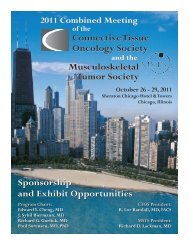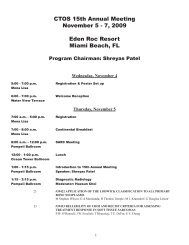207 Poster Session 2 - Connective Tissue Oncology Society
207 Poster Session 2 - Connective Tissue Oncology Society
207 Poster Session 2 - Connective Tissue Oncology Society
You also want an ePaper? Increase the reach of your titles
YUMPU automatically turns print PDFs into web optimized ePapers that Google loves.
Scientific <strong>Poster</strong>s – <strong>Poster</strong> <strong>Session</strong> 2physical functions included; nutritional status [nutritionalindex risk (NRI), average 95.7; albumin (average 37.3 g/L),weight loss (average 6.7%)], renal function [urea, average6.17 mmol/L; MDRD, average 74; Cockroft, average 58],hematological function [Hb, average 12 g/dL; leucocytes,average 6.5 Giga/L; lymphocytes, average 1.75 Giga/L].Tumors (T) were; gastric (n=37), and intestinal (n=17), localized(n=41), locally advanced (LA, n= 18), and metastatic(n=9), with a median size of 80 mm, with Miettinen risklow (n=19), intermediate (n=8), and high (n=30). Mutationswere documented in 19/23 cases, with KIT exon 11in 13 cases. Of localized/LA pts, 51 had resection of theprimary T (86%), with R0/R1 resections in 32/19 pts. Ptsreceived Imatinib post-operatively (n=31) or for advanceddisease (n=10). Twenty experienced severe toxicities. Witha median FU of 4.6 years (0-12.7), 55 pts (81%) are alive,but 27 (39.7%) relapsed. The 5-year OS and PFS rates are83% and 58.5% for the overall group.In Univariate analysis; ECOG >1, lymphocytes (< 1500),leucocytes (> 4000), Hb (≤ 11), non gastric T, metastases,negatively influenced OS, as urea (> 7.5) on PFS, but NRI(≤ 97.5), and albumine (< 35) had a negative impact onOS and PFS. Only age was significantly correlated withsevere toxicities.Conclusion: GIST pts over 65 receive similar treatmentsas younger pts, despite frequent nutritional deficits. Assessmentof nutritional status and improvement of thismetric in geriatric GISTs might positively influence theiroutcomes.<strong>Poster</strong> #124LOW DOSE IMATINIB MAY BE ACTIVE IN MANYGIST PATIENTS WITH INTOLERANCETO STANDARD DOSEMikael Eriksson, MD, PhD; Marie Ahlström<strong>Oncology</strong>, Skane University Hospital, Lund, SwedenObjective: Patients with severe side effects on standardor somewhat reduced doses of imatinib, 300-400 mg daily,are often considered intolerant to the drug and switched toanother tyrosin kinase inhibitor, usually sunitinib. However,several physicians treating GIST have experiencedthat low daily doses, 200 mg or less, may be both toleratedand active in such patients. There are, however, almost nowritten reports on this possibility, and there is an obviousrisk that some patients therefore will not get a chance toexperience a meaningful and even long-lasting responseto the drug.Methods: We collected data on a series of GIST patients atour institution who have been treated with imatinib doseslower than 300 mg daily to investigate whether a meaningfulresponse was observed and when they potentiallyrecurred. These patients will be presented.Results: Objective responses were noted on low or verylow doses of imatinib, even less than 100 mg daily in somepatients, and recurrences were not usual when the dosewas decreased because of toxicity.Conclusion: This limited series from one institution illustratesthat patients who seem intolerant to a standarddose of imatinib may well tolerate and respond to lowerdoses, and they should therefore not be withheld from thispossibility before switching to another drug. There may bean association between side effects and tumor sensitivityin GIST. Furthermore, intolerance may be best defined asnot tolerating the highest dose needed to prevent progression,which would also have implications for eligibilitycriteria in many clinical trials where the term intoleranceis poorly defined.<strong>Poster</strong> #125CORRELATION BETWEEN KIT EXON 11MUTATION SITE AND IMATINIB TREATMENTOUTCOME IN PATIENTS WITH ADVANCEDGASTROINTESTINAL STROMAL TUMORS (GIST)Agnieszka Wozniak 1 ; Piotr Rutkowski 3 ; Elzbieta Bylina 3 ;Maciej Matlok 6 ; Janusz Siedlecki 4 ; Maria Debiec-Rychter 2 ;Janusz Limon 51Laboratory of Experimental <strong>Oncology</strong>, Dept of <strong>Oncology</strong> and Dept of General Medical <strong>Oncology</strong>, KU Leuven andUniversity Hospitals Leuven, Leuven Cancer Institute,Leuven, Belgium; 2 Dept of Human Genetics, KU Leuvenand University Hospitals Leuven, Leuven Cancer Institute,Leuven, Belgium; 3 Dept of Soft <strong>Tissue</strong> and Bone Sarcoma andMelanoma, Maria Sklodowska-Curie Memorial Cancer Centreand Institute of <strong>Oncology</strong>, Warsaw, Poland; 4 Dept ofMolecular Biology, Maria Sklodowska-Curie MemorialCancer Centre and Institute of <strong>Oncology</strong>, Warsaw, Poland;5Dept of Biology and Genetics, Medical University of Gdansk,Gdansk, Poland; 6 Dept of Endoscopical Surgery, JagiellonianUniversity, Cracow, PolandObjective: Imatinib mesylate is a first line treatment forpatients with advanced GIST. However not all patientsbenefit equally from treatment. The correlation betweenGIST genotype (KIT exon 11 vs KIT exon 9 vs wild type)and treatment outcome has already been proven. RecentlyBlay et al. suggested that also site of primary KIT exon 11mutations could be considered as independent prognosticfactor for progression free survival (PFS) in GIST.Methods: We have reviewed files from 196 patients treatedwith imatinib between 2001 and 2011 because of advanceddisease at diagnosis (31.6%) or progression after surgery226






